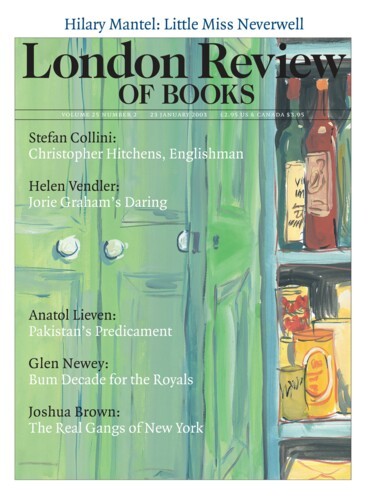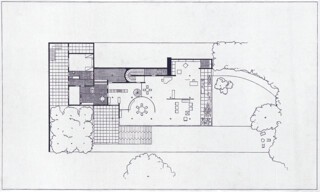The exhibition of the pre-American work of Mies van der Rohe at the Whitechapel Gallery until 2 March covers half a career – he was 52 when, in 1938, he moved to the States. Despite that, it follows a pattern you find in the early careers of most advanced 19th or 20th-century architects: suburban villas and housing, which proved you could see a job through, and competition entries which showed how you might handle big projects. Other ideas could, with luck, be tried out on temporary exhibition pavilions. Mies van der Rohe 1905-38 is dominated by photographs and models of built houses, unbuilt schemes, exhibition work and competition entries. The big buildings were still to come.
Of the glass skyscraper and the concrete office block designs of 1921-23 – the most famous of the unrealised schemes – there is little to say, if much to wonder at. It’s astonishing that three large drawings (and a few associated models) can so comprehensively sum up the aesthetic that dominated commercial architecture in the second half of the 20th century. These schemes, which are really agglomerations of identical cells, don’t invite you to walk through imaginary halls and rooms; but you can do that with the houses, and the house-like Barcelona Pavilion (computer graphics are supplied, so that even those who don’t like reading plans can have a go). The single family house is not a simple apprentice task for an architect: home life demands at least as much ingenuity in planning as office life. Imagining what it would be like to live in a house is more intriguing than imagining how it would feel to work in a bank, and amateurs have as much right as anyone to an opinion.
The question that always arises is whether the architect has to serve the client’s wishes or should plan for a better way of life. Mies’s later European houses – above all the most famous of them, the Tugendhat House in Brno – seem to offer, or perhaps threaten, an aesthetic which will not tolerate insensitivity to space. There will be no opportunistic gatherings of household furniture and certainly no untidiness: the architect is in charge. As time passed, he demanded more of the people he worked for – they paid for his vision by accepting his discipline, and their own taste was subsumed by, or grew into, his. A number of his clients collected art, but photographs of the interiors of the houses he designed for them don’t figure much in the pictures he kept in his archive. There is a strong feeling that he preferred rooms without decoration, enriched only by the materials he chose and the furniture he designed. A debate between a group of architects entitled ‘Can one live in the Tugendhat House?’ was published in Die Form in 1931 (an ‘infamous debate’, the catalogue* calls it). In his catalogue essay, ‘The Nature of Mies’s Space’, Barry Bergdoll explains that
by the end of the year Grete Tugendhat felt compelled to respond. ‘What has the architect given us?’ she asked rhetorically and responded, ‘An important feeling of existence’ (Daseinsgefühl), clearly evoking Heidegger, whose call on us to ask the all-important question ‘What is it, to be?’ seemed to her readily contemplated in this space.
She and her husband were clearly the kind of client Mies needed for the kind of building he refers to in a letter of 1926: ‘Twenty years ago I struggled to build good, decent and sensible buildings. Since then my ambition has changed. Building is an intellectual activity for me, therefore [I want] to be creative, and not just in details but in fundamentals.’
The ‘good, decent and sensible buildings’ – from his first commission, the Riehl House, which makes a bow to a German vernacular tradition through to neoclassical villas influenced by Schinkel – seem, from an English perspective, to run parallel to the path Lutyens took from farmhouse-like to mansion-like. What is different, one discovers from the densely researched catalogue, is the degree to which, from the beginning, Mies’s engagement with philosophical theories about man and nature informed his buildings. Arts and Crafts pragmatism and practicality had some influence in Germany, but England had produced no neoclassical building as rigorous as Schinkel’s, and no English architect would have been likely to invoke (as Mies did) neo-Platonism or Thomas Aquinas to justify his principles of planning and construction.
The present exhibition puts his first New York Museum of Modern Art show in context. He had been an American citizen for three years when, in 1947, he was invited to display his work and, almost as important, to control the way in which it was displayed. Terence Riley’s essay, ‘Making History: Mies van der Rohe and the Museum of Modern Art’, points out that what he put together was a visual demonstration of a style rather than a chronology – even an edited chronology – of development. Large, in some cases huge photographs of the Barcelona Pavilion, the Tugendhat House and the glass skyscraper projects were juxtaposed in ways that took less account of dates than of visual effect. The diversity of influences to be found in Mies’s architecture was never a secret – the classicism of Schinkel, the theories and experiments of European Modernists (architects and others) and the example of Frank Lloyd Wright are all evident. The 1947 show seems, with hindsight, to have been planned to provide a podium on which reductive structures with temple-like geometry (that’s to say, Mies’s American work: the Illinois Institute of Technology buildings, the Lake Shore Drive Apartments in Chicago, the Farnsworth House in Plano, Illinois, the Seagram Building) could later rise.
What America could not supply were patrons to match Fritz and Grete Tugendhat. The Farnsworth House led to recriminations from the client, and while the Seagram Building would not have been built if Phyllis Lambert, the daughter of Samuel Bronfman, the head of Seagram’s, had not persuaded him to use Mies, it wasn’t Heidegger and the ‘sense of being’ which made the building immensely influential. Vibrant space and fanatical care for detail, construction and materials could, it turned out, give glamour to commercial real estate.
To an English eye, it’s striking how foreign the origins of Mies’s Modernism seem, not just aesthetically, but socially. America took the style, but didn’t bother with the philosophy. In England, elements of the style turned up, but coloured by entirely different ideas about what a house and a community should be like. With the Mies show fresh in my mind I went to Bedford Park, near Chiswick, a development begun as a speculation by Jonathan Carr in 1875. Over the next ten years, houses, a church, an inn, a club and a school of art were built, first to the designs of E.W. Godwin, later to those of Norman Shaw and others. The art school was destroyed in the war and a few of the houses (the bigger ones in particular) have been replaced by blocks of flats or old people’s homes. But you can still drink your pint in the Tabard surrounded by De Morgan and Walter Crane tiles or sit on green Norman Shaw pews in the church. It then takes an hour or so to walk streets lined with almost unbroken rows of houses whose red brick or tile-hung walls, white woodwork, projecting rough-cast bays, substantial door canopies and picturesque irregularity of layout bring to mind a 19th-century picture-book illustration of an old market town somewhere in the south of England.
In Bedford Park the look went with a way of life. Artists came: you can still spot the high windows of studios. There are plaques to the Yeats family and to Lucien Pissarro – his father Camille also painted here. Freedom of thought and social progressiveness were encouraged: women could be members of the club. It was an easy place to make jokes about: ‘Greenery-yallery, Grosvenor Gallery’ and so on. Since Bedford Park in many ways prefigured what middle-class suburban families in the 20th century decided they wanted their lives to look like, it still is easy to mock. The visual style, intellectually a bit feeble, was, historically, surprisingly robust. The commune-like common purpose represented by the church, the club and the pub didn’t survive nearly so well as the aesthetic, but still coloured it.
Even when Miesian motifs are borrowed, there is more of Bedford Park in the schools, housing estates and New Towns of the 1950s and 1960s than there is of the Modernism Mies himself represented. The words and images in the exhibition recreate a moment in European intellectual life which is foreign to that English version of the modern, but equally foreign to that represented by style-magazine minimalism, Foster Associates’ production-line glazed bubbles and boxes, or the new New York. The sadness of loss pervades the exhibition. Although the Barcelona Pavilion was reconstructed and the war-damaged Tugendhat House restored, you are, despite the immense influence of the glass skyscraper drawings, aware of what died: a culture of which the architecture was a visual expression, but not the essence. Even if some late version of the convivial domesticity of Bedford Park is where you live, you leave the show with awe at the ambition of the experiment in building and living which Mies’s domestic work represents.
Send Letters To:
The Editor
London Review of Books,
28 Little Russell Street
London, WC1A 2HN
letters@lrb.co.uk
Please include name, address, and a telephone number.


